Bacon has become a breakfast staple for many around the world. But have you ever stopped to wonder where does bacon come from? It’s a bit of a misconception that bacon is its distinct cut of meat when it’s just a specific preparation of pork belly. Pork belly is the meat cut to create other dishes like pork belly bao or Korean BBQ samgyeopsal. So, when indulging in a crispy slice of bacon, you’re enjoying a part of the pig’s belly that has been cured and smoked. But how exactly does that process work to turn a plain slab of meat into the mouth-watering bacon we all know and love? Read on to find out more.
What is Bacon?
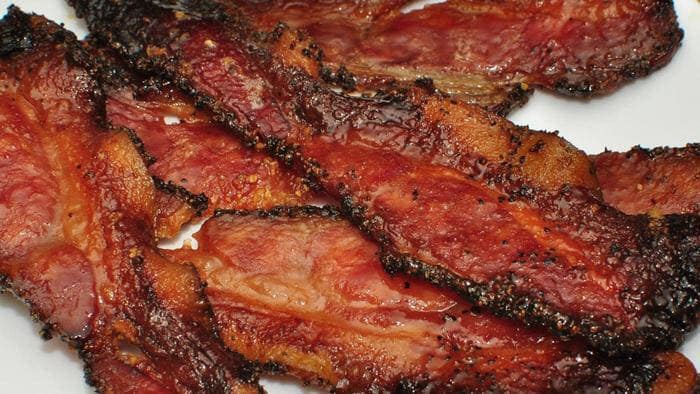
Bacon is a type of cured meat, usually made from pork belly. It is a popular breakfast item but can also be enjoyed in many other dishes. Bacon is generally cut into strips and cooked in a pan (or sometimes even grilled).
Bacon is usually cured with salt, sugar, and other ingredients, like spices, to give it flavor. The curing process helps to preserve the meat and keep it from spoiling. The curing process also gives bacon its characteristic smoky flavor.
Bacon is a tasty, versatile ingredient used in various dishes. It adds flavor to breakfast dishes like eggs and pancakes and is a great addition to sandwiches and burgers. It’s also a great topping for salads, potatoes, and other dishes. Bacon can also be cooked in different ways, like in the oven or stovetop.
The type of bacon you choose will depend on your taste and how you want to cook it. There are various bacon types, such as thick-cut, center-cut, and turkey bacon. Depending on the type, the cooking time and temperature will vary.
Where Does Bacon Come From?
Bacon is a beloved breakfast food that has its origins in ancient Rome. It is made from pork belly, an area of high-fat content giving bacon its signature streaky appearance. The pork belly is removed from the pig’s carcass, cured or smoked, and sliced into the delicious bacon we know and love today. Other types of bacon exist, like Canadian bacon, which is made from the lean loin portion of the pig. Despite its rich history, “bacon” originated from various Germanic and French dialects. From thick slabs to thin slices, bacon can be purchased in many forms. Whoever the manufacturer, bacon is an all-time favorite meat that can be savored with various dishes anytime.
What Is The Typical Weight Of A Pig Carcass Used For Bacon Production?
When it comes to bacon production, the typical weight of a pig carcass used can vary. However, according to factual data, most packers want pork carcasses that range from 170 to 225 pounds from pigs weighing approximately 230 to 300 pounds. Carcasses that weigh less than 170 pounds or more than 225 pounds may result in less desirable cuts of meat or penalties. The ideal market hog size for butchering is around 270 pounds.
Types Of Bacon
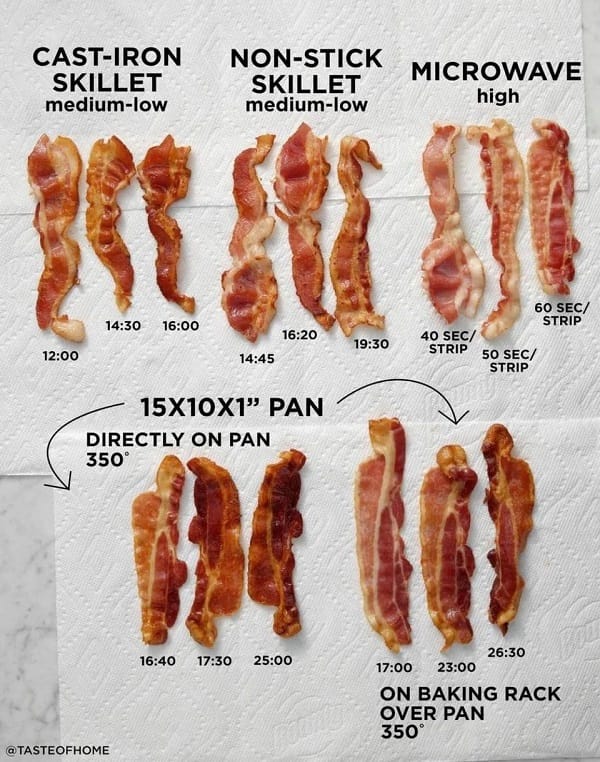
If you’re a bacon lover, it’s safe to say you’ve heard of all the different types of bacon out there. Bacon comes in all shapes and sizes, from thick-cut to hardwood-smoked, and can be made from pork or non-pork sources. We’ll be going over the different types of bacon and what makes each unique.
Slab Bacon
Slab bacon is the most traditional type of bacon and is the type that you typically see sliced and packaged in supermarkets. It’s cut from a single slab of pork belly that is then cured and smoked. Slab bacon is usually saltier and more intensely flavored than other types of bacon.
Center-Cut Bacon
Center-cut bacon is cut from the same slab of pork belly as slab bacon, but it is cut from the center of the slab, so it is leaner and has less fat. It is usually thinner and has less of a smoky flavor.
Hardwood Smoked Bacon
Hardwood smoked bacon is cured and smoked over a hardwood fire, which gives it a smokier flavor and a crispier texture.
Non-Pork Bacon
Non-pork bacon is made from other types of meat, including turkey, beef, and lamb. It has a slightly different texture and flavor than pork bacon, but it still has a smoky, salty taste.
Thick-Cut Bacon
Thick-cut bacon is cut from the same slab of pork belly as slab bacon, but it is cut thicker, which gives it a chewier texture and a more intense smoky flavor.
Precooked Bacon
Precooked bacon is a convenient choice for busy mornings. It’s already cooked and needs to be heated up. This type of bacon usually comes in thin slices and is often pre-seasoned with various spices.
Uncured Bacon
Uncured bacon is bacon that has not been treated with nitrates or nitrites. This type of bacon is usually leaner than other types of bacon and has a stronger smoky flavor.
Canadian Bacon
Canadian bacon is a type of bacon that is made from the leaner, center cuts of pork. It is usually smoked and has a milder flavor than other types of bacon.
Double Smoked Bacon
Double-smoked bacon is smoked twice, giving it a stronger, smokier flavor. This type of bacon is often used in dishes like BLT sandwiches.
Pancetta
Pancetta is a type of Italian bacon made from pork belly and cured for several weeks. It is usually thinly sliced and has a rich, salty flavor.
What Is Nitrate-Free Bacon, And Why Has It Become A Trend In Recent Years?
Nitrate-free bacon refers to bacon that does not contain sodium nitrate, a chemical compound that is used as a preservative in processed meats such as bacon. Nitrate-free bacon has become a trend in recent years because of growing concerns about the potential risks of consuming nitrate-containing foods. Nitrate-free bacon is often marketed as a healthier alternative to traditional bacon because it lacks the added preservative.
However, it is important to note that nitrate-free bacon still contains organic nitrates that can convert into nitrites in the body. Ultimately, the debate over nitrate-free bacon depends on an individual’s perspective on the potential health risks and benefits of consuming bacon.
What Are The Health Benefits Of Eating Bacon?
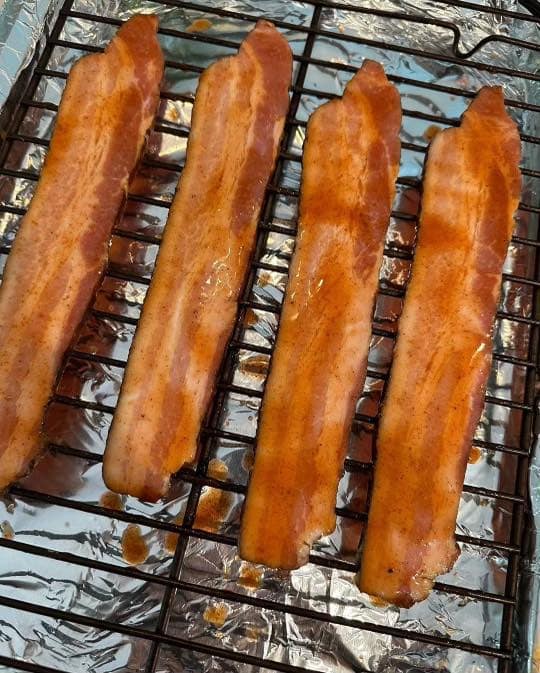
Bacon is a favorite food among many people, and it is no surprise that it can provide health benefits. Bacon is packed with protein, vitamins, and minerals and is a great dietary fat source. Eating bacon can provide several health benefits, including aiding in weight loss, providing essential nutrients, and improving digestion.
Protein: Bacon is an excellent source of protein and provides a good amount of the essential amino acids needed for muscle growth and repair. Eating bacon can help you get enough protein to maintain muscle mass.
Vitamins and Minerals: Bacon is a great source of several vitamins and minerals, including vitamins B1, B2, B3, B6, and B12. It is also a good zinc, magnesium, potassium, and phosphorus source. These vitamins and minerals are essential for maintaining a healthy body.
Essential Fatty Acids: Bacon is a great source of essential fatty acids, which are essential for good health. Omega-3 fatty acids found in bacon can help reduce inflammation, improve heart health, and reduce the risk of certain types of cancer.
Weight Loss: Eating bacon can help lose weight due to its low calorie and high protein content. Consuming a moderate amount of bacon and other healthy foods can help you achieve your weight loss goals.
Digestive Health: Bacon is a great source of dietary fiber essential for good digestion. Dietary fiber helps to slow down the digestion process, which can help to prevent constipation and other digestive issues.
Read more:
The Difference Between Smoked And Unsmoked Bacon
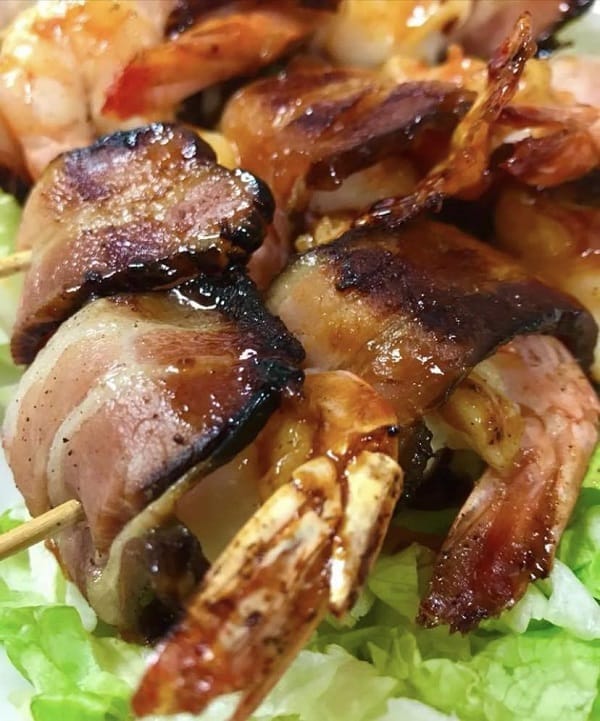
Smoked bacon is made with the same curing process as unsmoked bacon, except the bacon is hung in a smokehouse and is exposed to smoke from burning logs. This smoke adds flavor and color to the bacon, and it also helps to preserve it. Smoked bacon has a stronger, smoky flavor and a darker appearance.
Unsmoked bacon, on the other hand, is cured using a process of salting, which helps to preserve the meat and also adds flavor. Unsmoked bacon has a slightly milder flavor and a lighter color. It’s important to note that unsmoked bacon is still cured, just without the added smoke.
When it comes to cooking, both smoked, and unsmoked bacon can be used for various dishes. Smoked bacon is great for adding a smoky flavor to dishes like mac and cheese or potato salad. Unsmoked bacon is perfect for adding a salty flavor to dishes like omelets or quiches.
One thing to remember when cooking with either type of bacon is that it should be cooked at a lower temperature than other meats. This will help to preserve the flavor and prevent it from becoming too tough.
Does Cooking Bacon At Home Differ From Buying Pre-Cooked Bacon?
The main difference between the two types of bacon is the cooking method. Home-cooked bacon is typically cooked in a skillet on the stove, while pre-cooked bacon is microwaved or heated in the oven.
When cooking bacon at home, you’ll have more control over the level of crispiness. You can decide how long to cook it and get the bacon to your desired texture. This can be a challenge when microwaving pre-cooked bacon, as it’s difficult to predict exactly how long it will take to heat up.
Pre-cooked bacon is often pre-seasoned, whereas when cooking bacon at home, you can choose your seasonings. This means you can customize your bacon to your taste and make it as flavorful as you like.
Another key difference is that pre-cooked bacon is typically cheaper than home-cooked bacon. This makes it a great option if you’re on a budget. However, pre-cooked bacon is often higher in sodium, so if you’re watching your salt intake, you may opt for home-cooked bacon instead.
How Is Bacon Traditionally Prepared?
To understand the basics of bacon preparation, you first need to understand what bacon is. Bacon is cured pork belly that has been smoked, dried, and thinly sliced. The bacon preparation largely depends on the type of bacon you use and the region.
The most traditional way to prepare bacon is to dry-cure it. This involves rubbing the pork belly with a mix of salt, sugar, and spices and then allowing it to sit in a cool place for up to two weeks. The longer it sits, the saltier and drier the bacon will become.
Once the bacon has been cured, it can be smoked or unsmoked. Smoking adds flavor, color, and a smoky aroma to the bacon. Unsmoked bacon is typically lighter in color and has a more delicate flavor than smoked bacon.
Once the bacon has been cured and smoked (or left unsmoked), it is sliced thinly and packaged for sale.
For those looking for an alternative to traditional bacon, various other prepared bacon products are on the market. These include turkey bacon, veggie bacon, and even bacon-flavored snacks.
Can You Freeze Cooked Or Uncooked Bacon?
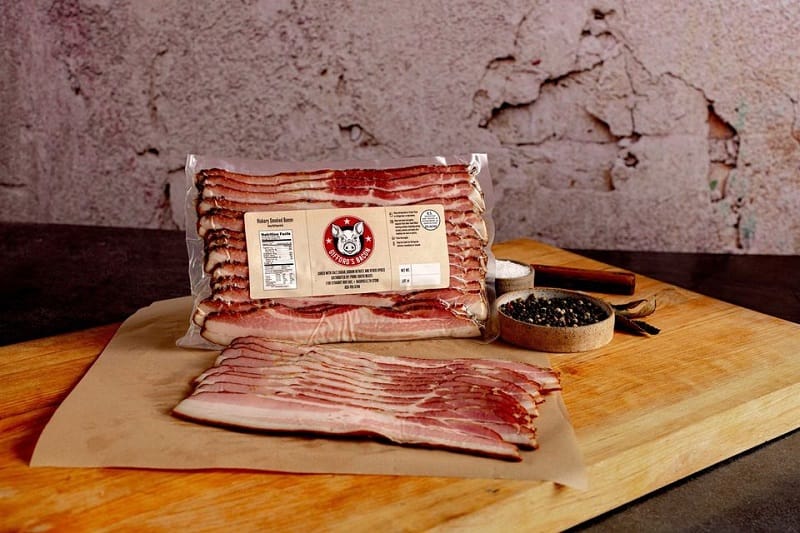
Smoked bacon is made with the same curing process as unsmoked bacon, except the bacon is hung in a smokehouse and is exposed to smoke from burning logs. This smoke adds flavor and color to the bacon, and it also helps to preserve it. Smoked bacon has a stronger, smoky flavor and a darker appearance.
Unsmoked bacon, on the other hand, is cured using a process of salting, which helps to preserve the meat and also adds flavor. Unsmoked bacon has a slightly milder flavor and a lighter color. It’s important to note that unsmoked bacon is still cured, just without the added smoke.
When it comes to cooking, both smoked, and unsmoked bacon can be used for various dishes. Smoked bacon is great for adding a smoky flavor to dishes like mac and cheese or potato salad. Unsmoked bacon is perfect for adding a salty flavor to dishes like omelets or quiches.
One thing to remember when cooking with either type of bacon is that it should be cooked at a lower temperature than other meats. This will help to preserve the flavor and prevent it from becoming too tough.
Why Is Bacon Grease Often Saved And Used In Other Recipes?
For a good reason, bacon grease is a staple ingredient in many kitchens worldwide. It’s full of flavor and can add an extra savory or smoky touch to many dishes. But why is bacon grease so often saved and used in other recipes?
For starters, bacon grease can enhance the flavor of so many different dishes. From scrambled eggs to baked potatoes, bacon grease can easily be added to a number of dishes. It adds a subtle richness and smoky flavor that can make a dish stand out.
In addition to adding flavor, bacon grease can be used as a cooking fat. It can fry up just about anything, from french fries to chicken wings. It has a higher smoke point than many other cooking fats, so that it won’t burn as easily. Plus, the bacon flavor it adds to the food is out of this world!
It’s also important to note that bacon grease is incredibly versatile. It can be used for baking, as an ingredient in dressings, or as a base for soup. It’s a great way to add subtle smokiness to a dish without a smoker.
Finally, saving bacon grease is an easy way to save money in the kitchen. A little goes a long way; it can be used multiple times before being discarded. It can last up to a month in the refrigerator if stored properly.
FAQs About Where Does Bacon Come From
How Much Fat Does Bacon Contain Compare To Other Meats?
When comparing bacon with other meats, such as beef or pork, it is important to consider the amount of fat. Bacon is often renowned for its high-fat content, but how does it compare to other meats?
Factual suggests that pork is typically the lowest in calories and saturated fat compared to other red meats. However, pork bacon has 12 times more saturated fat than meat, with 187g compared to meat’s 1.198g.
When comparing bacon to beef, it is clear that bacon has less protein and more saturated fat. This means that for those looking to balance their sodium, fat, and calorie intake, it is essential to read labels and choose leaner cuts of bacon for the best balance. Center-cut pork bacon is a great option as it is leaner than regular bacon and contains more protein and less fat. Another alternative for those looking to reduce their fat intake is turkey bacon, which typically contains fewer calories, fat, and sodium than pork bacon.
What Is The Difference Between Bacon And Side Pork?
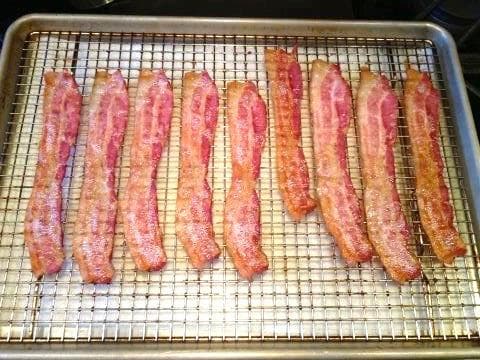
When it comes to pork, bacon and side pork may look similar, but they are quite different. Bacon is a type of cured meat that primarily comes from pork belly. On the other hand, side pork is the uncured and unprocessed slab of belly meat.
While both cuts come from the same pig area, bacon has been processed with curing salts, giving it that distinct taste and texture. The curing process also prolongs the shelf life of bacon, making it a popular choice for breakfasts, sandwiches, and salads.
On the other hand, side pork is a fresh cut of meat with high-fat content and is usually used for cooking and frying. So, while they may seem similar, the curing process sets bacon apart from side pork.
What’s The Difference Between Bacon, Sausage, And Ham?
Bacon, sausage, and ham are all popular pork products, but they have distinct differences. Bacon is a cut of pork that comes from the back of the pig, either the belly or loin. It is cured with salt and can be smoke-cured for additional flavor. Sausage, on the other hand, is a blend of ground meat and spices, often encased in a casing and cooked or smoked. Ham is a cut of pork taken from the pig’s thigh or rump and can be cured with salt and maybe smoked for added flavor.
Bacon can be eaten alone or used as an ingredient in dishes such as sandwiches, and salads, or as a topping for pizza. Sausage, meanwhile, can be added to dishes such as pasta, pizza, or breakfast casseroles. Ham is versatile and can be used in salads, sandwiches, and as a main course for dinner.
When looking at calorie intake, ham typically has fewer calories than sausage. For example, ham has 263 calories per 100 grams, while sausage has 324 calories per 100 grams. It is important to note that sausage can come in many different styles, such as breakfast sausage, chorizo, or Italian sausage, and each variety may have different nutritional values.
Conclusion
No matter where you live, it’s likely that bacon is a part of your diet. The next time you’re enjoying a delicious breakfast, lunch, dinner, or late-night snack, take a moment to appreciate the history and process of creating the bacon you love so much.
Do you have any questions about where does bacon come from? Let us know in the comments below.
References:
- https://www.washingtonpost.com/lifestyle/wellness/from-fish-to-bacon-a-ranking-of-meats-in-order-of-healthiness/2019/07/02/2de2dce0-9435-11e9-aadb-74e6b2b46f6a_story.html
- https://calories-info.com/beef-vs-bacon/
- https://s3.wp.wsu.edu/uploads/sites/2049/2021/02/02.21PorkFabVideoDataFactSheet02.16.2021.pdf

Hey readers! Chip Holland here, and I’m a Manager of this website. My passion for writing about it only matches my passion for BBQ. Follow my blog for mouth-watering recipes, tips, and tricks for the perfect smoke, grill, and BBQ. I’m sure you won’t be disappointed!
